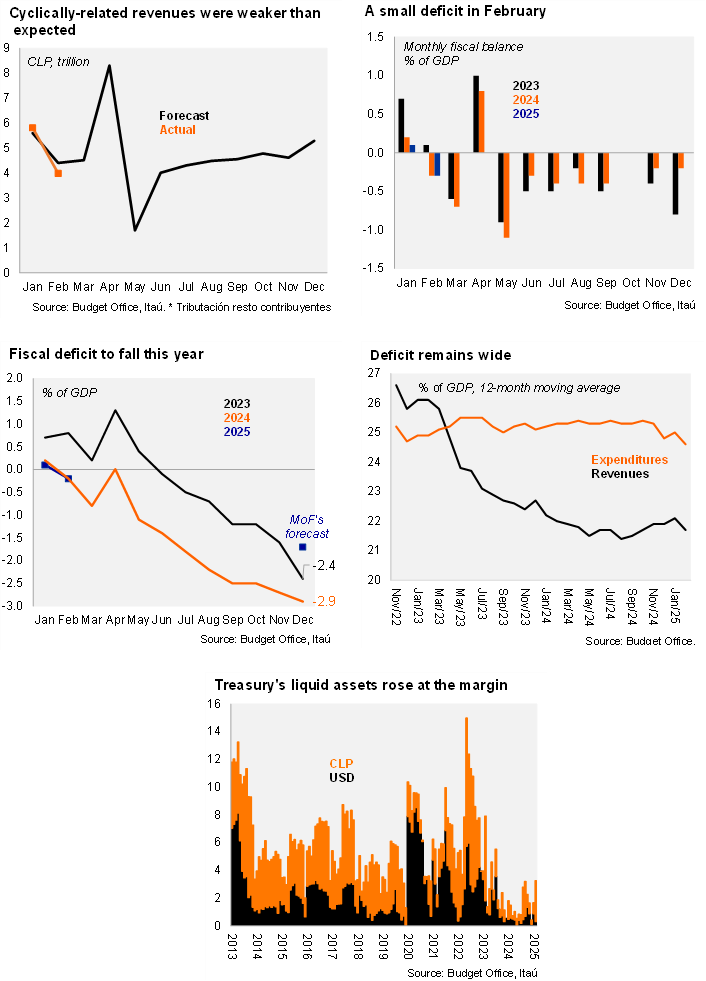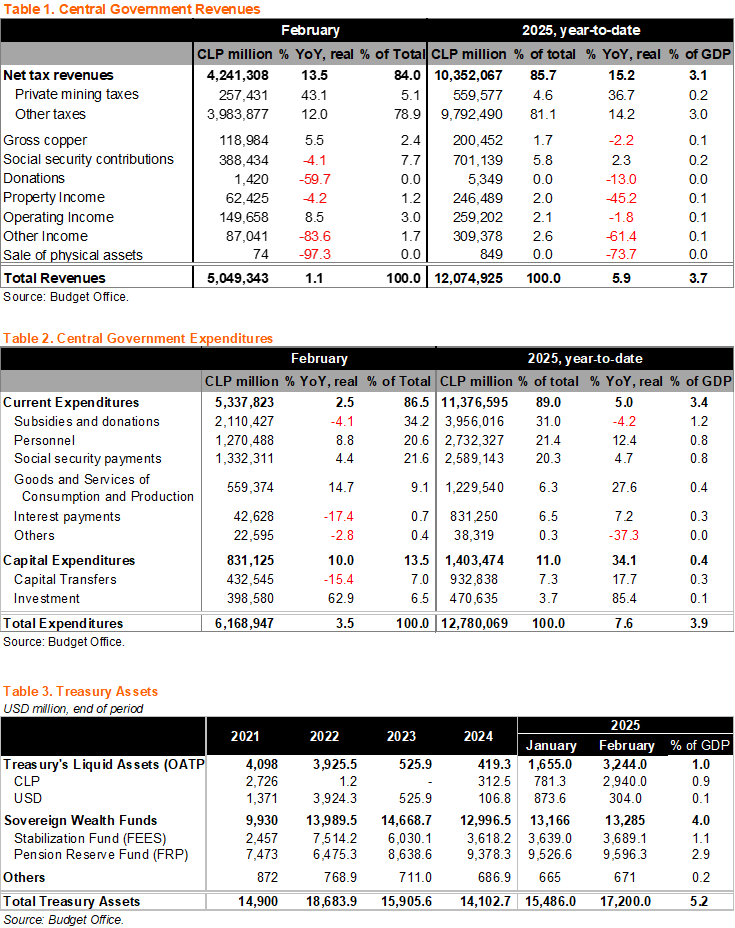Revenue improvement continued but slowed in February, due to base effects. After a strong 9.6% YoY increase in January, total real revenue growth slowed to 1.1% in February. Revenue growth was (again) mainly driven by cyclical factors and mining (also base effects due to the implementation of the revised royalty law, see Table 1), although base effects in “other revenues” weighed against a stronger expansion. Now, even though non-mining cyclically related revenues (which account for roughly 74% of the MoF’s annual revenues), increased by 12% YoY, they were still somewhat below our forecast (see chart). Real revenues accumulated in the year through February increased by 5.6%, below the MoF’s annual 8.0% forecast.
Still can’t kick the (spending) habit. Following last month’s spending binge (+11.8% YoY), in line with January 2024’s spending snapback, spending growth moderated in February to 3.5%. Current expenditure growth rose by 2.5% YoY in February (7.4% in January), while real capital expenditure rose by 10% (following an eye-popping 97.1% in January). Looking at the details, the moderation in spending was mainly due to a large decline in interest payments and certain base effects in subsidies and donations. The MoF appears to be frontloading again, as spending as a share of the annual budget reached 15.5%, the highest in the past two years. Spending will have to slow later in the year if the MoF plans on achieving its annual spending forecast of 2.7%.
Even though revenues rose again in the month, persistent spending growth led to a monthly fiscal deficit of 0.3% of GDP, same as in February 2024.
12-month rolling fiscal deficit remained unchanged at 2.9% of GDP in February. On a 12-month moving average basis as of the end of February, the central government’s revenues reached 21.7% of GDP, and expenditures 24.6% of GDP, leading to a cumulative deficit of 2.9% of GDP, unchanged since December 2024 (deficit of 3.4% of GDP in February 2024).
Liquid assets rose in February, driven by local currency debt issuance. Liquid assets in the Treasury (Otros Activos del Tesoro Público) rose in February to USD2.9 billion, from USD781 million by the end of January. In our view, the jump in CLP denominated assets was driven by local currency debt issuance in the month (roughly USD2.3 billion equivalent, mostly in notes maturing in August and October this year), and dollar sales (USD1 billion). AUM in the sovereign wealth funds were little changed, likely reflecting valuation effects. The Stabilization Fund (FEES) reached USD3.7 billion, and the Pension Reserve Fund (FRP) was slightly up to USD9.6 billion.
Dollar sales are likely to underperform the MoF’s guidance, and they may be absent all April. Having been on the sidelines since February 28, the Budget Office announced weekly sales guidance for dollar sales on March 18 of up to USD300 million per week through June. At the time we mentioned that the guidance was likely above market expectations, and we stated that the MoF was likely to sell significantly below the weekly cap, in line with their actions last year. In fact, dollar sales in March reached USD300 million, in line with our forecast of up to roughly USD400 million in the month. For April, we believe the MoF may be on the sidelines most of the month, as we envisage low liquid dollar cash balances by the end of March, and due to the seasonal jump in CLP cash balances, in turn due to tax season. Still, if they were to sell dollars in April, we estimate a monthly cap of roughly USD 400 million. The MoF sold a total of USD2.4 billion in 1Q25, above the USD1.9 billion of 1Q24. We envisage 2025 annual dollar sales at about USD8.4 billion (USD6.9 billion in 2024). Importantly, dollar sales finance the government’s fiscal needs (primarily in pesos), disregarding exchange rate considerations, consistent with Chile’s free-floating exchange rate regime.
Our take: This year’s fiscal consolidation forecast rests on additional spending restraint and continued revenue improvement. While we see little surprises in February’s fiscal data, our take is two-fold: spending growth will have to slow materially later in the year, while revenues must really pick up to meet the MoF’s annual forecast. Regarding the latter, all eyes will be on the results of April’s tax season, which primarily reflects last year’s rebound in economic activity. We view the recent spike in copper prices as transitory, with limited positive effects on the fiscal accounts. Still, the stage is set for a revised, less demanding structural deficit target in 2025. The most recent Public Finance Report (released in February) forecasted a 2025 structural deficit of 1.6% of GDP, above the 1.1% target, down from last year’s large 3.2%. We believe the next Public Finance Report (April 28) is likely to maintain an above target structural deficit along with a spending cut of roughly 0.5% of GDP. The Budget Office will release March’s fiscal data on April 30.


